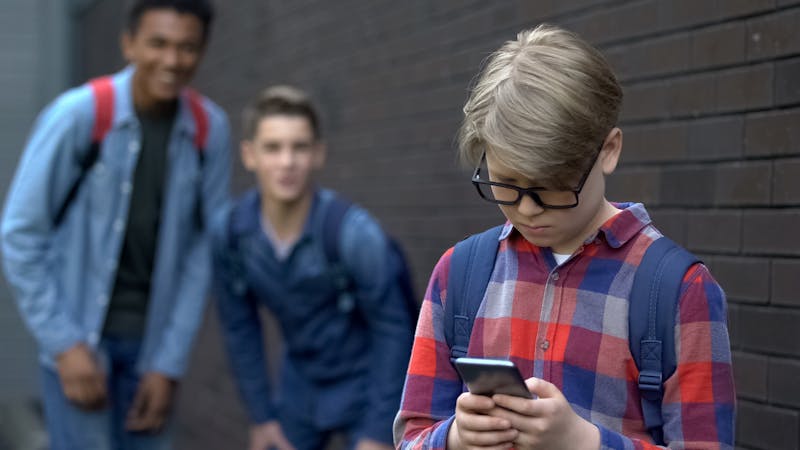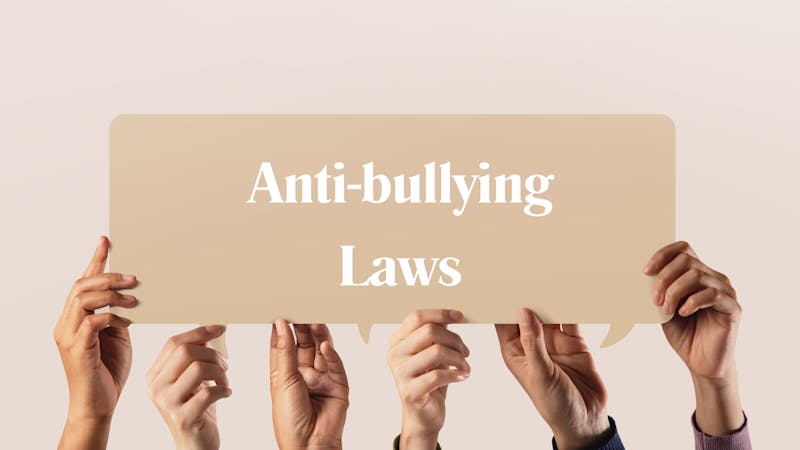All You Need To Know About Bullying: Online and Off
Anti-bullying Guide to Cyberbullying & Offline Bullying

Bullying can start as young as two years old, as children become more aware of the world around them and others, and 13% of tweens (9-12 years old) report experiencing bullying both at school and online, according to the Cyberbullying Research Center. While 25% of adults in the U.S. have repeatedly been given "the silent treatment," a form of bullying that is often misunderstood.
Bullying remains a prevalent issue in today's society, both offline and online, and it isn't one size fits all.
The impact of bullying can also be severe and long-lasting. Impacting the emotional, psychological, and physical well-being of those who experience it and those who are part of the problem.
Before we dig into anti-bullying resources and cyberbullying, let's recap the basics.
Common Types of Bullying
Bullying prevention is important, but research shows that bullying at work, bullying in school, and the most common types of bullying might not be as obvious as we think.
Trolling & Cyber Bullying
Cyberbullying and trolling can be extremely damaging, especially because a lot of it is done behind the anonymity of a screen and username. Dealing with online hate is tough; absolutely anyone can be affected by it. Trolling comes in many shapes and sizes. It could be bullying others, repeatedly posting controversial comments to get a reaction, provoking others, or posting someone's personal information online. Trolling is a form of cyberbullying to make another person feel scared, angry, self-conscious, or sad. It can take place on any digital device; it's often most common in online gaming rooms, forums, and other social media sites.
✅ Keep Safe Online
Cyberbullying occurs online, so ensuring your network and digital security are up to date is important. Make sure you have your IP address and browser activity masked while online. Ensuring that your children are staying safe online is also crucial. Activating child-safety features is recommended so they can't access inappropriate sites or information. IoT is designed to be enjoyed, but there are some things you can do to keep it fun and safe.
Relational Aggression
Relational aggression or relational bullying is sneaky and often goes unnoticed because it's very discrete and prevalent. This common type of bullying can include backstabbing, intimidation, spreading rumors, gossiping, or forming cliques. People who engage in relational bullying usually intend to harm another person's relationships, friendships, or social standing, and it doesn't just happen with the mean girls in high school. This non-physical form of bullying also happens in our workplaces, in friendship groups, and online.
Discriminatory Bullying
Discrimination means treating someone else differently because of their gender, sex, sexual preferences, race, ethnicity, or disability. Discriminatory bullying is when someone picks on or mistreats another person because of these perceived differences. This is why this type of bullying is often called prejudice bullying. As a common type of bullying, it could manifest in name-calling, racist slurs, physical attacks, or using the internet to harass someone by using the internet, texting, or other forms of digital bullying.
Verbal and Physical Bullying
Physical and verbal bullying can encompass all the other types above. Verbal bullying can occur online and offline and could turn into physical offline bullying.
Verbal bullying, in particular, is about using words and offensive language to hurt or intimidate someone else. Verbal bullying could include calling someone names, mocking them, or using derogatory comments.
On the other hand, physical bullying involves using physical force or aggression to harm or hurt someone else. Physical bullying can begin online through verbal insults and then turn physical when taken out of the digital space, though this isn’t always the case.
It's important to remember that different types of bullying, whether cyber or not, are often connected that can coexist and overlap.
How Common is Cyberbullying?
Cyberbullying is bullying that takes place digitally. It can happen to anyone who engages with others online, whether friends or complete strangers. This type of bullying is often assumed to only happen to young people. However, as more people use social media platforms and forums like Reddit, this type of bullying is becoming more prevalent; here are some cyberbullying statistics.
- 16% of students in grades 9-12 have experienced cyberbullying. (National Center for Education Statistics)
- 44.9% of LGBTQ students experienced electronic harassment in the past year (via text messages or postings on Facebook), often known as cyberbullying. (GLSEN)
- SEN students and those with disabilities are more likely to experience bullying, including online. (Anti-bullying Alliance)
- 1 in 5 tweens (8-12-year-olds) has been a victim of cyberbullying, cyberbullied, or known someone who's been harassed online. (Cyberbullying Research Center)
- 26% of 13-34-year olds believe that Instagram has the biggest problem with online abuse. (Cybersmile Foundation)
- 45% of 13-17-year-olds have experienced online bullying in their lifetime. (Cyberbullying Research Center)
Understanding The Impacts of Bullying (and how to help)
Bullying, whether online or offline, has a prolonged negative impact on people who experience it, which can leave a negative lasting impression long after the bullying finishes. Bullying can make people feel small and self-conscious, increasing emotional turmoil, including increased anxiety and feelings of depression, and decreasing desire and effort. Some people may experience physical manifestations of bullying, like trouble sleeping or sleeping too much, as the stress of bullying can cause physical symptoms. As well as mental and physical manifestations, people who have been bullied or cyberbullied may become more withdrawn, self-conscious, or less likely to pursue their dreams or goals. Remember, bullying and cyberbullying affect people in many ways, so providing a safe space for someone to talk about their experiences is key.
How to Help Someone Being Bullied
There are many ways that schools, businesses, families, and friends can help identify, prevent, and support those who are experiencing or who have experienced bullying.
Communication
Foster an open, supportive, inclusive, and empathetic environment where people feel they can discuss their feelings and experiences without repercussions. A positive environment can help those experiencing bullying to come forward quicker and prevent bullies from getting away with it.
Support
The pressure and sometimes embarrassment associated with talking about feelings can stop people from getting the help they need. Recommended helplines like The National Bullying Helpline can support people in talking about their experiences without feeling pressured or overwhelmed, as it can be anonymous.
Resources
Recommend professional support. When people get bullied, they can self-isolate because bullying and cyberbullying can make them feel bad about themselves, so much so that they might think they're the problem and don't deserve any help. Remind them that they deserve respect, support, and love, and if they need it you could guide them toward professional bullying prevention resources.
Anti-Bullying Resources
Bullying can be prevented like any other form of harassment, use of power, or negative behavior. Anti-bullying organizations like the ones below are united in their mission to reduce and eliminate any form of bullying, regardless of where you live.
Pacer’s National Bullying Prevention Center
Pacer is a childhood bullying prevention center aiming to ensure the safety and well-being of all students. Its classroom resources for educators, parents, and schools are free and interactive.
https://www.pacer.org/bullying/
Anti-Bullying Alliance
United against bullying? UBA is about supporting, sharing, and raising awareness of bullying throughout the UK. Its free CPD-online certified anti-bullying online training is for anyone who works with young people and kids.
https://anti-bullyingalliance.org.uk/
StopBullying
Research has shown that when we repeatedly stop bullying on the spot, we show kids that it's unacceptable, and it becomes less normalized. StopBullying is a federal government website. Learn about the signs of bullying, digital awareness for parents, and information about creating safe environments for youth with disabilities.
It Gets Better
A global movement to uplift, empower, educate, and connect LGBTQ+ people and allies worldwide. Its huge database of organizations spans over 40+ countries that offer support to young people in need or crisis, as well as anti-discrimination resources to make classrooms more accessible.
BulliesOut
In an ideal world, every organization and community worldwide would have its own anti-bullying team; BulliesOut works with communities and schools across the UK and offers educational guides to people worldwide on different types of bullying and bullying support for employees.
Internet Matters
Internet Matters' useful, short, educational videos are designed for parents and carers to navigate the internet safely, ensuring that kids have access to the digital world without all the nasty stuff.
https://www.internetmatters.org/
Inspirational words and smart ideas for standing up to bullies and bullying and personal stories for taking control of your narrative and learning more about the origins of the Crisis Text Line.
https://www.ted.com/playlists/191/stand_up_to_bullying
Cybersmile Foundation
On average, around 85% of Americans use the internet daily, meaning digital well-being has never been more important. The CyberSmile Foundation is committed to tackling online abuse through research, education, and awareness campaigns.
Not In Our Town
Inclusive communities are beautiful. Not In Our Town and Not In Our School projects by an Oakland-based nonprofit creates stop-hate action kits for communities to work toward more inclusive futures with actionable steps against discriminatory bullying and hate crimes.
Cyberbullying Research Center
The Cyberbullying Research Center is committed to providing fact-checked cited resources for educators, parents, and caregivers to understand what cyberbullying is, how it can affect young people, and its prevalence, as well as information about bullying laws across the US.
Anti-Bullying Facts, Laws & Policies
Many countries, states, and regions have specific anti-bullying legislation to address harassment, bullying, and physical assault. These laws can vary, but they generally define bullying, give victims a place to report bullying, and outline consequences for bullies, which could include criminal punishment.
US Bullying Laws
In the U.S., each state has its own set of bullying laws, so all 50 states have now enacted some form of anti-bullying legislation. Cyberbullying Research Center has the full list.
Bullying Based on Discrimination
There isn't a federal law that specifically applies to bullying. However, sometimes, when bullying is based on race, gender, sex, disability, or religion, it can overlap with harassment, so organizations and schools are legally obliged to report it to the U.S. Department for Civil Rights.
Workplace Bullying
There aren't currently any federal or state laws prohibiting workplace bullying. Local anti-discrimination laws, however, might cover members of underrepresented and marginalized communities. In the workplace, the first step would be to file a complaint with their human resources department or contact the Equal Employment Opportunity Commission (EEOC.)
6 R’s of Bullying Prevention
The 6 R's of bullying prevention are a set of strategies and approaches to address and reduce bullying behavior. These strategies empower individuals, foster empathy, and create a positive and inclusive environment. The 6 R's are:
#1 Rules
Establish clear and comprehensive rules and expectations. These rules should emphasize respect, kindness, and empathy.
#2 Recognize
Create a culture of awareness and recognition by educating individuals about the signs and effects of bullying.
#3 Report
Encourage individuals to report bullying incidents promptly and confidentially. Ensure that reporting is taken seriously and appropriate actions are taken to address each case sensitively.
#4 Respond
When bullying is reported or observed, it is crucial to respond promptly, appropriately, and seriously ensuring the consequences are fair and consistent.
#5 Refuse
Create a culture of collective responsibility where individuals can actively work to prevent and stop bullying.
#6 Replace
Replace bullying behavior with positive alternatives. Create and keep an environment that promotes kindness, empathy, and inclusion.
Resources
- Gordon, S. What is Relational Aggression?
https://www.verywellfamily.com/relational-aggression-bullying-460498 - Cyberbullying Research Center - Tween Cyberbullying in 2020
https://i.cartoonnetwork.com/stop-bullying/pdfs/CN_Stop_Bullying_Cyber_Bullying_Report_9.30.20.pdf - Unicef - Cyberbullying, what is it and how to stop it.
https://www.unicef.org/end-violence/how-to-stop-cyberbullying - Respect me - Prejudice-based bullying
https://respectme.org.uk/bullying/prejudice-based-bullying/ - EDC - How does early bullying develop?
http://preventingbullying.promoteprevent.org/3-how-does-early-bullying-develop - PACER - 5 Important facts, Students with Disabilities and Bullying
https://www.pacer.org/bullying/info/students-with-disabilities/


